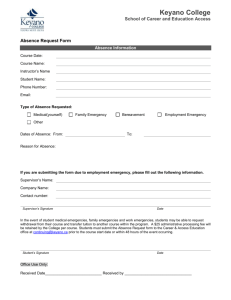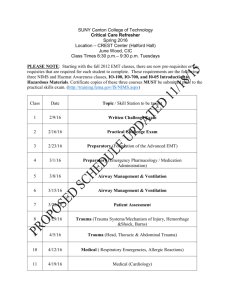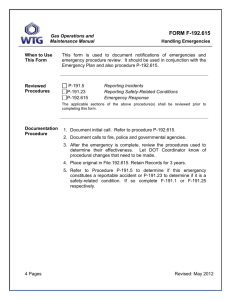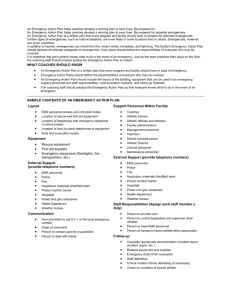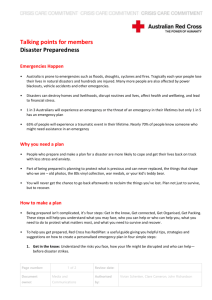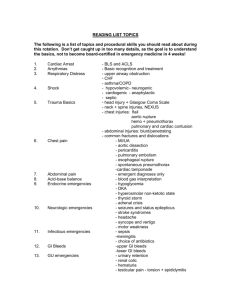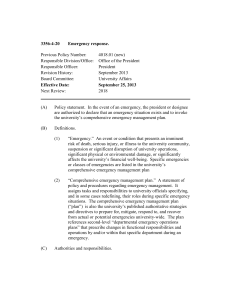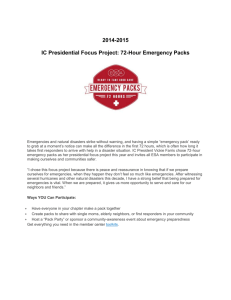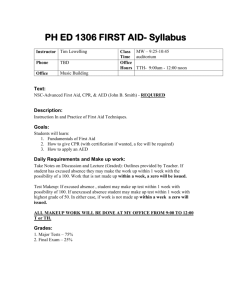Emergency Medical Technician - Basic
advertisement
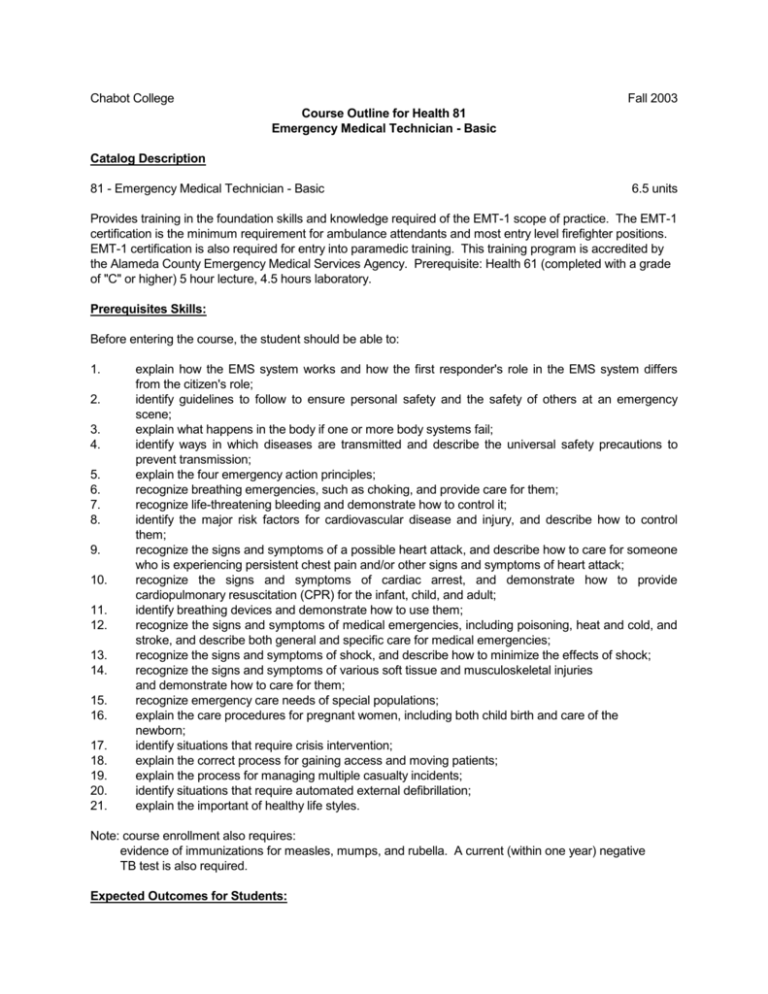
Chabot College Fall 2003 Course Outline for Health 81 Emergency Medical Technician - Basic Catalog Description 81 - Emergency Medical Technician - Basic 6.5 units Provides training in the foundation skills and knowledge required of the EMT-1 scope of practice. The EMT-1 certification is the minimum requirement for ambulance attendants and most entry level firefighter positions. EMT-1 certification is also required for entry into paramedic training. This training program is accredited by the Alameda County Emergency Medical Services Agency. Prerequisite: Health 61 (completed with a grade of "C" or higher) 5 hour lecture, 4.5 hours laboratory. Prerequisites Skills: Before entering the course, the student should be able to: 1. 2. 3. 4. 5. 6. 7. 8. 9. 10. 11. 12. 13. 14. 15. 16. 17. 18. 19. 20. 21. explain how the EMS system works and how the first responder's role in the EMS system differs from the citizen's role; identify guidelines to follow to ensure personal safety and the safety of others at an emergency scene; explain what happens in the body if one or more body systems fail; identify ways in which diseases are transmitted and describe the universal safety precautions to prevent transmission; explain the four emergency action principles; recognize breathing emergencies, such as choking, and provide care for them; recognize life-threatening bleeding and demonstrate how to control it; identify the major risk factors for cardiovascular disease and injury, and describe how to control them; recognize the signs and symptoms of a possible heart attack, and describe how to care for someone who is experiencing persistent chest pain and/or other signs and symptoms of heart attack; recognize the signs and symptoms of cardiac arrest, and demonstrate how to provide cardiopulmonary resuscitation (CPR) for the infant, child, and adult; identify breathing devices and demonstrate how to use them; recognize the signs and symptoms of medical emergencies, including poisoning, heat and cold, and stroke, and describe both general and specific care for medical emergencies; recognize the signs and symptoms of shock, and describe how to minimize the effects of shock; recognize the signs and symptoms of various soft tissue and musculoskeletal injuries and demonstrate how to care for them; recognize emergency care needs of special populations; explain the care procedures for pregnant women, including both child birth and care of the newborn; identify situations that require crisis intervention; explain the correct process for gaining access and moving patients; explain the process for managing multiple casualty incidents; identify situations that require automated external defibrillation; explain the important of healthy life styles. Note: course enrollment also requires: evidence of immunizations for measles, mumps, and rubella. A current (within one year) negative TB test is also required. Expected Outcomes for Students: Chabot College Course Outline for Health 81, page 2 Fall 2003 Upon completion of this course, students should be able to: 1. explain the roles and responsibilities of the EMT-1; 2. describe functioning within the Alameda County EMS System and the established policies, procedures, and protocols; 3. recognize conditions and situations that require pre-hospital care and/or stabilization; 4. perform rapid, comprehensive, and accurate patient assessment; 5. perform with competence all skills and interventions within the EMT-1 scope of practice; 6. manage multi-casualty incidents effectively; 7. demonstrate the proper use and maintenance of all equipment used by the EMT-1; 8. explain the medical/legal aspects of emergency care and issues related to proper documentation, confidentiality, and ethics; 9. assist paramedics with the delivery of advanced life support within the EMT-1 scope of practice; 10. prevent disease transmission through the use of body substance isolation; 11. discuss wellness issues such as stress management, body mechanics, lifting techniques, and use of personal protective equipment. Course Content: 1. 2. 3. 4. Preparatory a. Roles and responsibilities of the EMT-1, medical direction, quality improvement, and continuing education b. Well being of the EMT-1, body substance isolation, protective equipment, and scene safety c. Medical, legal and ethical issues; review of Federal, State and local laws pertinent to EMT-1 scope of practice. Confidentiality, advance directives and ethical/moral issues are discussed d. Basic anatomy, physiology, and medical terminology e. Vital signs and patient history, review and development of skills learned in prerequisite coursework f. Techniques for lifting and moving patients with a focus on body mechanics and injury prevention Airway Management a. Ventilation and oxygen therapy b. Comprehensive study of respiratory function and anatomy of adult and pediatric patients c. Utilization of airway adjuncts including: endotracheal intubation, oxygen administration techniques and utilization for infants and C.O.P.D. patients Patient Assessment a. Scene Evaluation - determination of mechanism of injury, resource needs, and identification of scene hazards b. Patient evaluation - assessment based approach to patient evaluation; diagnosis of specific injuries and illness is de-emphasized; integration of patient assessment techniques into overall scene management and treatment modalities c. Assessment of Geriatric Patients - understand the differences between the average adult, geriatric, and pediatric patient d. Communications - skills, equipment, and systems used by the EMT-1. Emphasis on medical direction and on-line communications e. Documentation - utilization of the "Prehospital Care Report" and standardized data set established by the 1994 DOT EMT-1 curriculum Medical, Behavioral, and Obstetrics/Gynecology a. General Pharmacology - Medication terminology, indications, contraindications, dosage, actions, and side effects of the six medications with the EMT-1 scope of practice b. Respiratory Emergencies - signs and symptoms of breathing difficulty and respiratory Chabot College Course Outline for Health 81, page 3 Fall 2003 c. d. e. f. g. h. i. j. k. l. m. n. 5. distress. Pathophysiology of common respiratory conditions. Review of adult and pediatric anatomy, training in treatment modalities for respiratory distress and failure Cardiac Emergencies - signs and symptoms of cardiac compromise. Pathophysiology of cardiovascular disease. Recognition of acute cardiac events and rapid intervention Automated External Defibrillation - awareness level training in the use of A.E.D. equipment by EMT-1 Altered Mental Status, diabetic emergencies - recognition of the signs and symptoms of altered mental status and the relationship to life threatening conditions. Pathophysiology of diabetic emergencies and prehospital treatment Altered Mental Status with Loss of Function - understanding of the cause, nature and care of patients with cerebrovascular accidents and transient ischemic attacks altered Mental Status, seizures and syncope - review the causes, nature and treatment of patients experiencing a loss of consciousness or seizure activity Allergic reactions - recognition of the signs and symptoms of anaphylaxis and prehospital care of these patients including the use of an epinephrine auto-injector with medical direction Poisoning emergencies - recognition of the signs and symptoms of accidental or intentional poisonings and the management of these patients. Use of activated charcoal for poisoning under medical direction Drug and alcohol emergencies - recognition of the signs and symptoms of alcohol and drug emergencies and the management of these patients Acute abdominal pain - discussion of the pathophysiology of acute abdominal pain and recognition of urgent situations requiring management and rapid transport Environmental Emergencies - recognition of the signs and symptoms of hypothermia and hyperthermia and related conditions. Management of these patients in the prehospital environment Drowning, near-drowning and diving emergencies - understanding of water related emergencies with an emphasis on rescuer safety Behavioral emergencies - awareness, recognition and management of behavioral emergencies with an emphasis on scene and rescuer safety Trauma a. Mechanism of injury - Kinetics of trauma, study of the physics of motion that may produce injury, patterns of injury produced by vehicle accidents, falls, projectiles b. Bleeding and shock - recognition and management of internal and external bleeding and decreased perfusion states c. Soft tissue injuries - management of various types of soft tissues injuries with emphasis on bleeding control and hypoperfusion d. Burn emergencies - recognition and management of thermal, chemical, and electrical burns with emphasis on inhalation injuries and rescuer safety e. Musculoskeletal injuries - recognition and management of sprains, strains, and fractures. Review of splinting techniques and assessment f. Injuries to the head - recognition and management of head injury patients with an emphasis on airway management and altered mental status g. Injuries to the spine - utilizing scene size-up and mechanism of injury considerations to maintain a high index of suspicion of spinal injury. Utilize various methods of spinal immobilization and patient extrication h. Eye, face and neck injuries - recognition and management of facial injuries with emphasis on airway management and spinal stabilization i. Chest, abdomen and Genitalia injuries - recognition and management of chest, abdominal, and genitalia emergencies and identification of life threatening injuries Chabot College Course Outline for Health 81, page 4 Fall 2003 j. 6. 7. Agricultural and industrial emergencies - special situations that require specialized teams of rescuers or equipment. Review of scene safety and evaluation Infants and Children a. Anatomical and physiological differences between children and adults b. Injuries and illnesses in infants and children Operations a. Moving patients - study of the various techniques and equipment for moving patients. Identify the need for emergency, urgent and non-urgent moves. b. Ambulance operations - maintenance and operation of the ambulance as well as cleaning, disinfection and disposal of contaminated items c. Gaining access and extrication - awareness of rescue procedures and recognition of the need for special training and equipment for technical rescue situations d. Hazardous Materials emergencies - first responder awareness training as required by Title 22. Cognition of Haz-mat incidents and rescuer safety e. Multiple casualty incidents - utilizing the incident command system and standardized triage systems for the management of multiple casualties Methods of Presentation: 1. 2. 3. Lectures in basic concepts and skills Scenario-based skills lab Supervised clinical rotation Typical Assignments and Methods of Evaluating Student Progress: 1. Typical Assignments a. Lecture 1) Respiratory Emergencies b. Reading 1) Read chapter 14 in text, respiratory emergencies 2) Review airway management skills in skills book c. Skills Lab 1) Practice patient evaluation skills in small groups with assistant instructor 2) As a team, manage a simulated gunshot victim and critique performance with assistant instructor d. Written Assignment 1) Complete a case study on three patients, one from each clinical experience. 2) Complete a five-page written analysis of a current issue affecting EMS. 2. Methods of Evaluating Student Progress: a. Objective examinations and quizzes, including a midterm and final exam 1) A total of 12 quizzes are administered and typically consist of 50 multiple choice questions on the previous week’s topic 2) A 175-question multiple choice midterm exam is given 3) A 250-question multiple choice final examination is given at the completion of the course. This is a certifying exam that is approved by the Alameda County EMS District b. Skills Evaluations 1) Skills are evaluated periodically as they are mastered. Skills evaluations are graded on a pass/fail basis based on criteria established by the National Registry of Chabot College Course Outline for Health 81, page 5 Fall 2003 2) 3) Emergency Medical Technicians A final certifying skills evaluation is done at the completion of the program. Students are responsible for all skills within the EMT-1 scope of practice Performance in the clinical environment is subjectively evaluated by the nurse/preceptor Textbook(s) (typical): 1. 2. 3. 4. Emergency Care of the Sick and Injured (textbook), AAOS, 8th edition, 2002 Emergency Care of the Sick and Injured (workbook), AAOS, 8th edition, 2002 EMT Skills Book, Steve Prziborowski, 2002 EMT Student Notes, Steve Prziborowski, 2002 Special Student Materials: 1. 2. 3. Penlight Stethoscope Tape - 1 roll of 2" white medical Revised: 10/22/02
